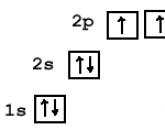Presentation on the topic "social protection of the unemployed". Presentation on the topic of social protection of the unemployed Presentation of social support for the unemployed citizens
In accordance with Art. 28 of the Law on Employment of the Population, the state provides unemployed citizens with the following types of social support: - payment of unemployment benefits; - payment of scholarships during the period vocational training, advanced training, retraining in the direction of the employment service, including during the period of temporary disability; - opportunity to participate in paid public works; - reimbursement of expenses in connection with a voluntary move to another locality for employment at the suggestion of the employment service; - Support for small business.

If a citizen is registered as unemployed, then the periods of time during which he receives unemployment benefits, scholarships in the manner prescribed by law, takes part in paid public works, do not interrupt the length of service and are counted in the total length of service.

Unemployment benefit is state-guaranteed material support for the unemployed in the form of periodic payments. Unemployment benefits are paid from the federal budget. The allowance for unemployed citizens dismissed for any reason is set as a percentage of the average earnings calculated over the past three months at the last place of work.

... are determined according to the rules established by Art. 33 of the Law on Employment of the Population, and are: - in the first three months of unemployment - in the amount of 75 percent of their average monthly earnings (monetary allowance), calculated for the last three months at the last place of work (service); - in the next four months - in the amount of 60 percent; - in the future - in the amount of 45 percent, but in all cases not more than living wage, calculated in the subject Russian Federation in the prescribed manner, and not less than 20 percent of the specified subsistence minimum. At the same time, the amount of unemployment benefit should not be less than 100 rubles.

... can be carried out at the direction of the employment service, if: - the citizen does not have a profession (specialty); - it is impossible to find a suitable job because the citizen does not have the necessary professional qualifications; - it is necessary to change the profession (specialty, occupation) due to the lack of work that meets the citizen's professional skills; - the citizen has lost the ability to perform work in the former profession (specialty).

Public work is understood as labor activity that has a socially useful orientation and is organized as additional social support for citizens, job seekers. Public works can be organized in the following areas: construction of roads, their repair and maintenance; carrying out agricultural work; housing construction, reconstruction of housing stock; maintenance of passenger transport, work of communication organizations;

Special program "Grants for start-up small businesses to create own business» The program provides for grants to small businesses in the form of subsidies for cost recovery in the form of mandatory payments associated with state registration legal entities or individual entrepreneurs, costs associated with starting a business, financing targeted costs for the payment of the first installment when concluding an equipment leasing agreement, payments for the transfer of rights to a franchise

To use the preview of presentations, create an account for yourself ( account) Google and sign in: https://accounts.google.com
Slides captions:
Rights and obligations of the unemployed. Economic and social costs of unemployment. State regulation of employment.
RIGHTS OF THE UNEMPLOYED 1) choosing a place of work by direct appeal to the employer; 2) free consultation and free receipt of information in the bodies of the employment service for choosing the field of activity, employment, vocational training opportunities; 3) free vocational guidance, vocational training, retraining and advanced training in the direction of the employment service; 4) independent job search and employment outside the territory of the Russian Federation; 5) appeal against the decision, actions or inaction of the employment service bodies and their officials to the higher body of the employment service, as well as to the court in the manner prescribed by the legislation of the Russian Federation; 6) social support in the form of: a) payment of unemployment benefits, including during the period of temporary disability; b) payment of scholarships during the period of vocational training, advanced training, retraining in the direction of the employment service; c) providing an opportunity to participate in public works; d) reimbursement of expenses in connection with voluntary relocation to another locality for employment at the suggestion of the employment authorities.
OBLIGATIONS OF THE UNEMPLOYED TO come to the employment service for re-registration at least once a month; participate after a three-month period of unemployment in paid work or undergo training in the direction of the employment authorities (for persons specified in the law); appear for negotiations on employment with the employer within three days from the date of referral by the employment service; to come to the employment service to receive a referral for study (work); inform the employment agency about self-employment, enrollment in full-time education, call for military service(fees); choose one of the two options offered by the employment agency suitable job.
SOCIAL CONSEQUENCES OF UNEMPLOYMENT Negative Positive 1. Aggravation of the crime situation. 2. Increased social tension. 3. Growth in the number of physical and mental illnesses. 4. Zoom social differentiation. 5. Decrease in labor activity. 1. Increasing the social value of the workplace. 2. Increase personal free time. 3. Increasing freedom to choose a place of work. 4. Zoom social significance and labor values.
ECONOMIC CONSEQUENCES OF UNEMPLOYMENT Negative Positive 1. Devaluation of the consequences of training. 2. Reducing production. 3. The cost of helping the unemployed. 4. Loss of qualification. 5. Decline in living standards. 6. Underproduction of the national income. 7. Reduced tax revenue. 1. Creation of a reserve of labor force for the restructuring of the economy. 2. Competition between workers as an incentive to develop the ability to work. 3. Break in employment for retraining and education. 4. Stimulating the growth of labor intensity and productivity.
Main directions state regulation labor market program to stimulate employment growth and increase the number of jobs in the public sector. programs aimed at training and retraining the workforce. the government adopts unemployment insurance programs, that is, allocates funds for unemployment benefits to programs to promote the recruitment of labor.
GOALS OF STATE REGULATION OF THE LABOR MARKET
ACTIVE POLICY stimulating state investment in the economy, which is the main condition for creating new jobs; organization of retraining and retraining of the structurally unemployed; development of employment services, labor exchanges that carry out intermediary functions in the labor market, the provision of information on vacant jobs in order to reduce frictional and structural unemployment; promotion of small and family entrepreneurship, which is being considered in many countries the most important method ensuring employment of the population; government incentives (by tax and legislative measures) for the provision of jobs by employers certain groups population - youth, disabled people; facilitating, if necessary, a change of residence in order to obtain a job; the international cooperation in solving employment problems; resolving issues related to international labor migration; creation of jobs in the public sector - in the field of education, medical services, public utilities, construction of public buildings and structures; organization of public works.
PASSIVE FORM providing social support in the form of unemployment benefits, material assistance and other social benefits; free medical care.
LABOR EXCHANGE is a special institution that performs intermediary functions in the labor market. In most countries, labor exchanges are state-owned and operate under the direction of the ministry of labor or a similar body, however, in the labor market, along with public services employment, there are a large number of private intermediary firms, the efficiency of which is very high.
MAIN ACTIVITIES OF LABOR EXCHANGES: registration of the unemployed; registration vacancies; employment of the unemployed and other persons; studying the labor market situation and providing information about it; testing of persons wishing to get a job; professional orientation and professional retraining the unemployed; payment of benefits.
STATE POPULATION EMPLOYMENT POLICY system of measures of direct state and indirect impact on the labor sphere (labor market) to achieve the set goals.
multilevel process public policy employment macro level regional level local level
MACRO LEVEL Coordination of goals and priorities of employment policy with economic, social, demographic and migration policies. Coordination of the system of goals and priorities of the employment policy with financial, credit, structural, investment, foreign economic policy. Development of a policy of employment and social support for the unemployed population.
REGIONAL LEVEL development of the system of training and retraining of the population (primarily the temporarily unemployed); improvement information support(including computerization); provision of adapted premises and trained personnel of employment centers; targeted support for jobs to contain the layoffs of workers; improving the efficiency of registration, employment and social support for the unemployed; support in the labor market for refugees and forced migrants, citizens with limited ability to work, long-term unemployed, women, youth and adolescents and other socially unprotected groups of the population; organization of public and temporary works.
LOCAL LEVEL practical work employment, benefits, training.
Description of the presentation on individual slides:
1 slide
Description of the slide:
Social guarantees for unemployed citizens under the laws of the Russian Federation © 2007 Microsoft Corporation. All rights reserved. Microsoft, Windows, Windows Vista and other product names are or may be registered trademarks and/or trademarks in the United States and/or other countries. The information in this document is for illustrative purposes only and does not represent the views of Microsoft representatives as of the date of this presentation. As Microsoft is forced to take into account the changing market conditions, it does not guarantee the accuracy of the information provided after the preparation of this presentation, nor does it assume such a duty. MICROSOFT MAKES NO WARRANTIES, EXPRESS, IMPLIED OR STATUTORY, AS TO THE INFORMATION IN THIS PRESENTATION.
2 slide
Description of the slide:
The unemployed as an object of social protection The unemployed are able-bodied citizens who do not have a job and earnings, are registered with the employment service in order to find a suitable job, are looking for a job and are ready to start it.
3 slide
Description of the slide:
Registration of unemployed citizens is carried out by the employment authorities at the place of residence in the following order: 1) registration of citizens in search of suitable work; 2) registration of unemployed citizens; 3) selection of a suitable job.
4 slide
Description of the slide:
The status of the unemployed implies a number of powers, which in turn guarantee the rights of citizens to employment, these are: 1. the right of citizens to choose a place of work; 2. the right of citizens to consultation, vocational guidance, assistance in moving and relocating to another area for employment, psychological support, vocational training and additional professional education, obtaining information from the employment service; 3. the right of citizens to professional activity outside the territory of the Russian Federation; 4. the right of citizens to appeal against the actions of the employment service bodies and their officials.
5 slide
Description of the slide:
Guarantees of social support for the unemployed Unemployment allowance Additional allowance for the unemployed who were exposed to radiation as a result of the Chernobyl disaster Stipend for unemployed citizens One-time subsidy for unemployed citizens to create their own business Compensation payments to the unemployed related to the cost of registering a business Opportunity to participate in paid public works Early appointment of a pension Social material aid
6 slide
Description of the slide:
Unemployment benefit Unemployment benefit is state-guaranteed material support for the unemployed in the form of periodic payments.
7 slide
Description of the slide:
Scholarship for the unemployed vocational education in the direction of the employment service, including during the period of temporary disability.
8 slide
Description of the slide:
One-time subsidy to unemployed citizens to create their own business Government "On additional measures aimed at reducing tension in the labor market of the constituent entities of the Russian Federation". The amount of the subsidy for the unemployed to create their own business in 2017 is 58,800 rubles.
9 slide
Description of the slide:
Opportunity to participate in paid public work Public paid work is a variety of low-skilled activities that have a socially useful orientation. These include landscaping and landscaping, cleaning courtyards and house entrances, cleaning stations and bus stops, agricultural work, restoration of monuments, repair of roads, retail, consumer services for the population, office work in state institutions, care for the sick and the elderly, social work with teenagers, as well as distributing newspapers and delivering mail.
10 slide
Description of the slide:
11 slide
Description of the slide:
12 slide
Description of the slide:
The first task is to ensure the flexibility of the labor market and the reduction of illegal employment, including: - ensuring a balance between the cost of labor, social protection measures for workers and maintaining the competitiveness of manufactured products; - Ensuring compliance with established norms and rules in the field of labor market regulation and labor relations, increasing the effectiveness of control and supervision over their implementation; - reducing the level of illegal employment; - development social partnership; - improving the efficiency of use labor resources in the public sector; - stimulating the development of flexible forms of employment for the population, including those that do not require a permanent presence at the workplace.
13 slide
Description of the slide:
The second task is to improve the quality of the workforce and develop a system for retraining personnel, taking into account development priorities regional economy, including: - development of in-house training for employees of organizations subject to layoffs; - development of a system of retraining and advanced training aimed at increasing the competitiveness of employees in the labor market, including in-house training; - development of career guidance programs for young people aimed at increasing the prestige of working professions and stimulating the growth of professionalism of workers; - orientation of schoolchildren, increasing their motivation for labor activity by professions and specialties in demand on the labor market, as well as to employment entrepreneurial activity; - development of a system of psychological support for the population.
14 slide
Description of the slide:
The third task is to ensure the growth of employment and the efficiency of the use of labor, including by increasing the territorial mobility of labor resources, including: - improving the quality of services in the field of promoting employment of the population; - encouraging the unemployed to active search work; - development information resources and ensuring their availability in the field of employment; - stimulation of labor immigration, improvement of the system for providing state support citizens and their family members relocating for work, including subsidizing the costs of moving and settling down; - development of partnership mechanisms between business, local and regional authorities, public organizations to ensure effective employment of the population, protection against unemployment, social adaptation, retraining of workers laid off from jobs in connection with the modernization of enterprises, the introduction of labor-saving technologies; - creation of new jobs through the opening of new enterprises, the introduction of new industries in operating enterprises;
15 slide
Description of the slide:
"Labor Market and Employment"- Plan. Distinguish between nominal and real wages. I.2 Typology and structure of the labor market The labor market has a complex structure. In system economic relations the labor market plays an important role. Relevance of the topic. In connection with the restructuring taking place in our country, there is a restructuring of the labor market.
"Features of the labor market" - Was formulated in the XIX century. Law of diminishing returns. Some or at least one of the factors of production. Negative values of the marginal product of labor. marginal product labor. Formula. Owner small firm. Labor market. Labor market. Result. How will the total product of labor change?
"Labor market"- A farm that grows tomatoes. Types of labor markets. demand in the labor market. Characteristics of goods in the labor market. Whether construction workers should be included in the labor market supply. Fill the table. What is the labor market. The nature of labor services. Owners. Labor mobility. Statement. How demand is formed.
"Labor resources of Russia"- Analysis of the use of labor resources. Application (use) of forecasting methodology. Additional need. Calculations of additional demand. Calculation additional demand. Workforce planning. Planning of public education. Forecast of the balance of labor resources in Russia.
"Demand and Supply for Labor"- Demand and supply for labor. The structure of the labor market by profession. Market volume. Job search. Labor supply. Satisfied demand. Labor competition. unemployment statistics. Labor resources. Problems of the labor market. The structure of the labor force and human capital. Labor force situation.
"Employment"- Active population in retirement and pre-retirement ages. The level of demographic load. Reproduction of labor resources. Self-employed. Suitable and inappropriate work. Consequences. Factors of social differentiation in the structure of employment. The growth of the working-age population in Russia. The working potential of the country.
Popular
- Celebration of the day of agriculture and processing industry
- When is Agriculture Day celebrated?
- Card games at the table
- Funny and funny contests for a fun company of adults
- Polish "paratroopers" for the Soviet marines
- Project 205 missile boats
- How is life on the new Chinese destroyer
- The newest frigate "Admiral of the Fleet Kasatonov" is preparing for the first tests and going to sea Ship Admiral Kasatonov
- Submarines of the Gato type
- Insignia on the merchant fleet of the USSR Detachment of the II group




